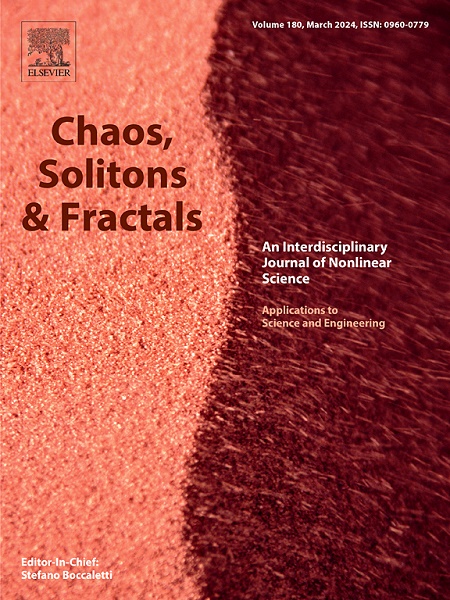Effects of higher-order interactions and electromagnetic induction on synchronization in Hindmarsh–Rose neuronal networks
IF 5.3
1区 数学
Q1 MATHEMATICS, INTERDISCIPLINARY APPLICATIONS
引用次数: 0
Abstract
Synchronization phenomena in neuronal networks have a key role in cognitive functions and neural information processing. This study investigates the synchronization behavior of neuronal networks under the combined influence of electromagnetic induction and higher-order interactions. We construct a simplicial complex that incorporates both first- and second-order couplings, and introduce electromagnetic induction into the Hindmarsh–Rose neuronal model. Using the master stability function method and numerical simulations, we analyze the effects of electromagnetic induction strength and the proportion of higher-order interactions on synchronization stability and energy distribution. The results show that moderate electromagnetic induction helps reduce the synchronization threshold and enhances energy uniformity across the network. In contrast, increasing the proportion of higher-order interactions introduces stronger structural heterogeneity and significantly suppresses the synchronization. Spectral analysis reveals an intrinsic link between declining synchronization stability and structural features. Furthermore, simulations on the real-world Dolphin social network validate the generality of the proposed mechanism. This study highlights the synergistic effects of electromagnetic regulation and higher-order coupling in neuronal dynamical systems and provides theoretical insights into synchronization mechanisms in complex networks.
高阶相互作用和电磁感应对Hindmarsh-Rose神经网络同步的影响
神经网络中的同步现象在认知功能和神经信息处理中起着关键作用。本文研究了电磁感应和高阶相互作用共同作用下神经元网络的同步行为。我们构建了一个包含一阶和二阶耦合的简单复合体,并将电磁感应引入Hindmarsh-Rose神经元模型。利用主稳定函数法和数值模拟,分析了电磁感应强度和高阶相互作用比例对同步稳定性和能量分布的影响。结果表明,适度的电磁感应有助于降低同步阈值,提高整个网络的能量均匀性。相反,增加高阶相互作用的比例会引入更强的结构异质性,并显著抑制同步。光谱分析揭示了同步稳定性下降与结构特征之间的内在联系。此外,在真实海豚社交网络上的仿真验证了所提出机制的通用性。本研究强调了电磁调节和神经元动力系统中高阶耦合的协同效应,并为复杂网络中的同步机制提供了理论见解。
本文章由计算机程序翻译,如有差异,请以英文原文为准。
求助全文
约1分钟内获得全文
求助全文
来源期刊

Chaos Solitons & Fractals
物理-数学跨学科应用
CiteScore
13.20
自引率
10.30%
发文量
1087
审稿时长
9 months
期刊介绍:
Chaos, Solitons & Fractals strives to establish itself as a premier journal in the interdisciplinary realm of Nonlinear Science, Non-equilibrium, and Complex Phenomena. It welcomes submissions covering a broad spectrum of topics within this field, including dynamics, non-equilibrium processes in physics, chemistry, and geophysics, complex matter and networks, mathematical models, computational biology, applications to quantum and mesoscopic phenomena, fluctuations and random processes, self-organization, and social phenomena.
 求助内容:
求助内容: 应助结果提醒方式:
应助结果提醒方式:


